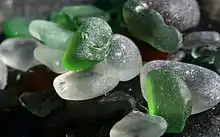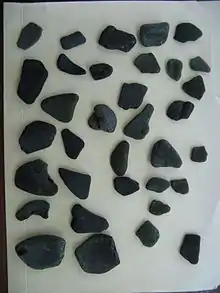
Sea glass are naturally weathered pieces of glass, which often have the appearance of tumbled stones. Sea glass is physically and chemically weathered glass found on beaches along bodies of salt water. These weathering processes produce natural frosted glass.[1] Sea glass is used for decoration, most commonly in jewellery. "Beach glass" comes from fresh water and is often less frosted in appearance than sea glass. Sea glass takes 20–40 years, and sometimes as much as 100–200 years, to acquire its characteristic texture and shape.[2] It is also colloquially referred to as drift glass from the longshore drift process that forms the smooth edges. In practice, the two terms are used interchangeably.
Formation
Sea glass begins as normal shards of broken glass that are then persistently tumbled and ground until the sharp edges are smoothed and rounded. In this process, the glass loses its slick surface but gains a frosted appearance over many years.[3]
Naturally produced sea glass ("genuine sea glass") originates as pieces of glass from broken bottles, broken tableware, or even shipwrecks, which are rolled and tumbled in the ocean for years until all of their edges are rounded off, and the slickness of the glass has been worn to a frosted appearance.[4] Then, the glass will wash to shore where it may be collected.
Colors
The color of sea glass is determined by its original source, and most sea glass comes from bottles. Besides pieces of glass, colored sea pottery pieces are often also found.[3]
The most common colors of sea glass are kelly green, brown, white, and clear. These colors predominantly come from glass bottles mostly used by companies that sell beer, juices, soft drinks, and other beverages. The clear or white glass comes from clear plates and glasses, windshields, windows, and assorted other sources.[5]
Less common colours include jade, amber (from bottles for whiskey, medicine, spirits, and early bleach bottles), golden amber or amberina (mostly used for spirit bottles), lime green (from soda bottles during the 1960s), forest green, and ice- or soft blue (from soda bottles, medicine bottles, ink bottles, and fruit jars from the late 19th and early 20th centuries, windows, and windshields). These colors are found about once for every 25 to 100 pieces of sea glass found.[5]
Uncommon colors of sea glass include a type of green, which comes primarily from early to mid-1900s Coca-Cola, Dr Pepper, and RC Cola bottles as well as beer bottles. Soft green colors could come from bottles that were used for ink, fruit, and baking soda. These colors are found once in every 50 to 100 pieces.[5]
Purple sea glass is very uncommon, as is citron, opaque white (from milk bottles), cobalt blue and cornflower blue (from early Milk of Magnesia bottles, poison bottles, artwork, Bromo-Seltzer and Vicks VapoRub containers), and aqua (from Ball Mason jars and certain 19th century glass bottles). These colors are found once for every 200 to 1,000 pieces found.[5]
Extremely rare colors include gray, pink (often from Great Depression-era plates), teal (often from Mateus (wine) bottles), black (older, very dark olive green glass), yellow (often from 1930s Vaseline containers), turquoise (from tableware and art glass), red (often from old Schlitz bottles,[6] car tail lights, dinnerware, or nautical lights, it is found once in about every 5,000 pieces), and orange (the least common type of sea glass, found once in about 10,000 pieces). These colors are found once for every 1,000 to 10,000 pieces collected. Some shards of black glass are quite old, originating from thick eighteenth-century gin, beer, and wine bottles.[5]
Antique black sea glass

Old black glass bottles that had iron slag added during production to increase strength[7] and opaqueness were at times broken in shipment.[8]
Artificial
In order to make artificial sea glass, a tumbler, sand, and glass are necessary.[9]
A number of characteristics highlight the differences between artificial sea glass and natural sea glass, starting with the coloration and surface texture of each piece.[10] An example of natural sea glass will usually have a frosty, almost powdery texture at different points.[10] One of the most reliable indicators for natural sea glass is a C-shaped design all over the outside of the sample.[11] If the design is located on the piece, it is authentic sea glass, since artificial glass will typically not have that particular design.[11] Sea glass usually comes from broken glass bottles or other household items, so pieces found on beaches will not be perfectly shaped, unlike artificial sea glass, often sold as beach glass.[11]
See also
References
- ↑ "What is Sea Glass or Beach Glass". bytheseajewelry.com. Retrieved 2023-10-22.
- ↑ "The Godfather of Sea Glass: Richard LaMotte Boosts the National Profile of Sea Glass Retrieved". Sea Glass Journal. Retrieved February 19, 2015.
- 1 2 "What Is Sea Glass?". Find Sea Glass. Retrieved 31 July 2018.
- ↑ Park, Elizabeth. "Where Does Beach Glass Come From?". USA Today. Demand Media. Retrieved November 6, 2014.
- 1 2 3 4 5 La Motte, R (2009). Pure Sea Glass. Sea Glass Publishing. ISBN 978-0975324608.
- ↑ Dean, Cornelia (October 18, 2010). "From junk to collectible, shaped by time and tide". New York Times.
- ↑ "Black Sea Glass, Black Beach Glass". odysseyseaglass.com. Retrieved 24 February 2015.
- ↑ "Antique Black Glass Bottles". Antique Bottle Collector's Haven. Retrieved 24 February 2015.
- ↑ Cathy (2012-06-28). "How to Make Fake Sea Glass". FIND SEA GLASS. Retrieved 2020-11-08.
- 1 2 Messerschmidt, Peter. "The Issue of Natural vs Fake ("Man Made") Sea Glass". North Beach Treasures. Archived from the original on 2016-06-23.
- 1 2 3 "North American Sea Glass Association". Retrieved 2018-07-31.
Further reading
- Park, Elizabeth. "Where Does Beach Glass Come From?". USA Today. Retrieved November 6, 2014.
- National Geographic magazine, "Environment" section: "The Shard Way", August 2008
- http://www.microscopy-uk.org.uk/mag/artnov11macro/JosephineWyman/JW_SeaGlassArticle.pdf
External links
- North American Sea Glass Association
- Fortune Small Business magazine article on sea glass collection
- Washington Post article on sea glass collection and sales
- Photographic Exploration of Sea Glass- Josephine Wyman
- Brief summary/discussion about Sea Glass / Beach Glass